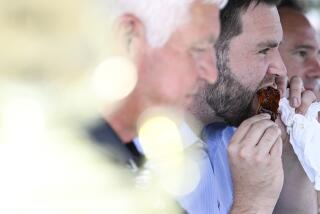BOOK REVIEW / NONFICTION : Rethinking Our Appetite for Diet Overkill : CONSUMED <i> by Michelle Stacey</i> ; Simon & Schuster, $21, 237 pages
- Share via
Michelle Stacey thinks that we’ve forgotten how to eat--or rather, how to enjoy eating.
If the 1980s were all about excess, from leveraged buyouts to Brie baked with walnuts, the 1990s are the lean decade. Reasonable savings programs and soy cheese melted on a plain bagel.
We’ve gone overboard again, in what she considers a boring direction: We’ve started to see food not as a sensory experience but as nutritional fuel; it’s no longer part of the good life, but a sinful temptation that we must deny.
Her book, “Consumed,” is a collection of essays that analyzes how we got to this tasteless pass, and how everyone from chefs to food technologists feel about it.
She’s particularly interested in the men and women who are trying to give us immortality in a muffin, such as Paul and Barbara Stitt, flaxseed apostles who run a bakery in Wisconsin, and Norm Singer, who invented the first FDA-approved fat substitute.
Stacey sticks with individuals involved in the fray, either as food futurists or as critics of the trend toward regimented eating. She has a wicked, fine eye for the ironic detail and a lovely, clean style; no literary cream or butter clog up her prose.
The portraits she draws are crystalline; if only she’d looked around just a bit more, to see what, besides a desire for control, influences the way we eat. It’s not just over- or underweight people who get crazy about food. Even a middle-of-the-road eater has trouble getting by in a world full of messages about how we all ought to eat better and, more to the point, look different.
It takes a healthy ego to survive a day’s worth of image mongering, particularly for women: What have we come to when Brooke Shields, who hardly qualifies as Rubenesque, does jazzy TV commercials about how to lose a couple of pounds? Why is Cindy Crawford the only mega-model who even vaguely resembles a human being instead of a beanpole?
Whatever sane things we manage to tell ourselves about how to eat, popular culture says we haven’t measured up. Stacey addresses the issue of eating disorders in one of her essays, but she is more interested in the relationship between dieting and the individual’s illusion of control than in the larger social conspiracy.
The control she imposes on her material--blocking off subjects into essays, never letting the philosophical peas slop over onto the potatoes--keeps the flavors clear but precludes a broader understanding of what’s at work. Stacey reminds us that eating disorders were not invented in the 1980s; still, it would be nice if she’d cast her analytical net a bit further out.
One of Stacey’s best essays is “Public Eating: Serving the Food Phobes,” in which she takes us into professional kitchens to hear what restaurateurs and chefs think about the trend toward custom orders (sauce on the side, no-oil salad dressings, an imaginative assortment of efforts to purge the demon fat from a menu).
Santa Fe’s Mark Miller manages to communicate more succinctly what Julia Child has been saying for years: that a teaspoon of lard in a tamale is not as threatening as the pool of olive oil a misguided diner dunks his bread in, that our campaign for dietary control is based on a lot of misinformation.
He’s right, of course. There is something sad, finally, about diners so terrified of a nutritional misstep that they deny themselves the dishes the chef has created. (Can you think of another art form where the consumer has the audacity to edit the artist?)
But there’s another kind of obsession that gets less ink because it implies macho immortality--the diner who powers through too much food and drink simply to prove he can, the embodiment of the great American pioneer spirit.
It’s painful to watch a woman agonize over a lettuce leaf, as though she wished she had a squeegee to remove its dressing. It’s also painful to watch an overweight man (the ghosts of his artery-clogged relatives tsk-tsking at his shoulder) barrel through a damn-the-torpedoes dinner because he can’t cope with reality.
Stacey focuses on the trend toward food-wrangling, toward bending what we eat to do our will--a hopeless and somewhat comic task, finally, since nobody gets out of here alive, regardless of what they eat. Perhaps sanity sits not in blithe disregard but in the reasonable middle range.
More to Read
Sign up for our Book Club newsletter
Get the latest news, events and more from the Los Angeles Times Book Club, and help us get L.A. reading and talking.
You may occasionally receive promotional content from the Los Angeles Times.









